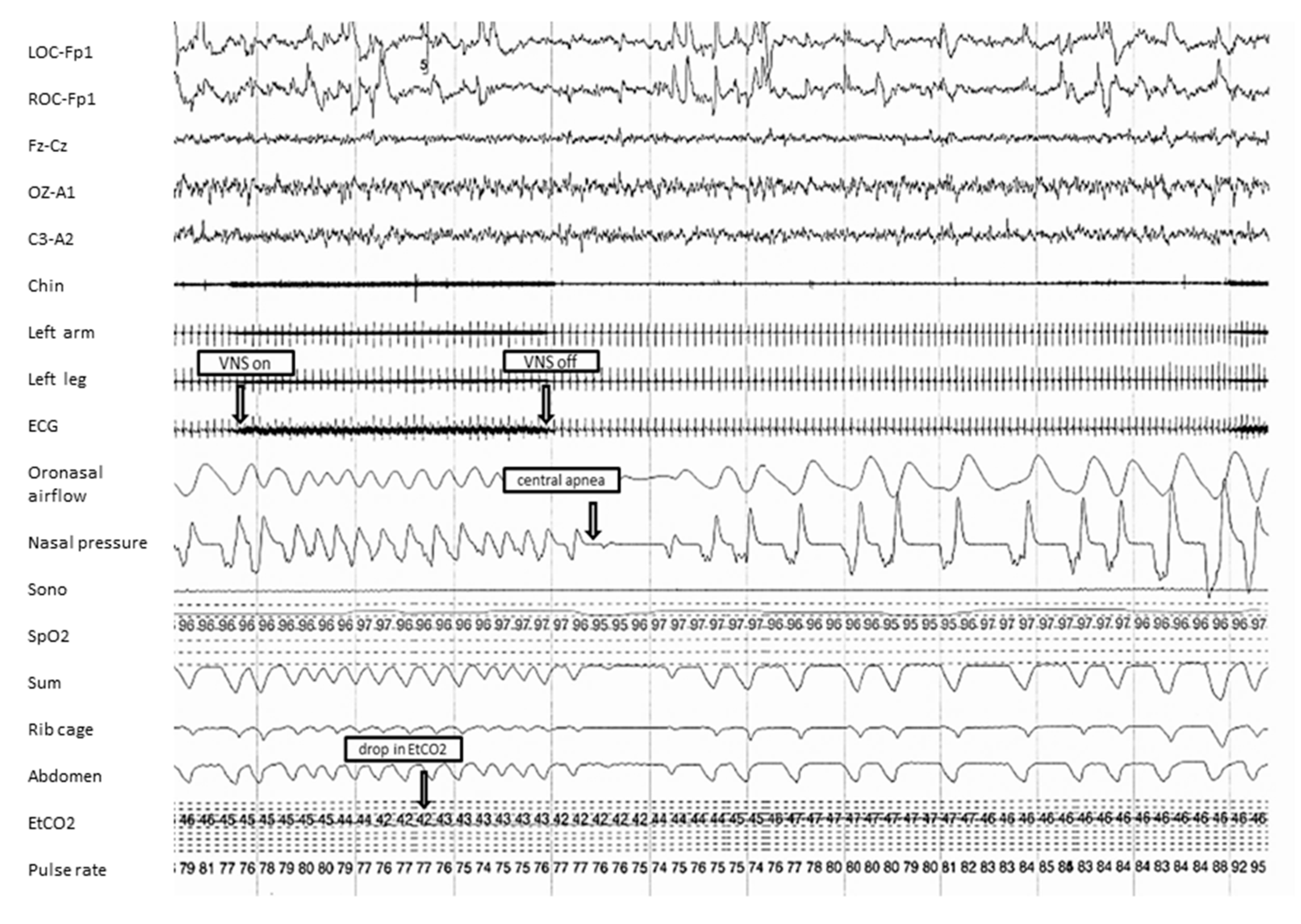A Potential Novel Mechanism for Vagus Nerve Stimulator-Related Central Sleep Apnea
Abstract
:1. Introduction
2. Case Presentation
3. Discussion
4. Conclusions
Acknowledgments
Author Contributions
Conflicts of Interest
References
- Miller, J.W.; Hall, C.M.; Holland, K.D.; Ferrendelli, J.A. Identification of a median thalamic system regulating seizures and arousal. Epilepsia 1989, 30, 493–500. [Google Scholar] [CrossRef] [PubMed]
- Parhizgar, F.; Nugent, K.; Raj, R. Obstructive sleep apnea and respiratory complications associated with vagus nerve stimulators. J. Clin. Sleep Med. 2011, 7, 401–407. [Google Scholar] [PubMed]
- Malow, B.A.; Edwards, J.; Marzec, M.; Sagher, O.; Fromes, G. Effects of vagus nerve stimulation on respiration during sleep: A pilot study. Neurology 2000, 55, 1450–1454. [Google Scholar] [CrossRef] [PubMed]
- Marzec, M.; Edwards, J.; Sagher, O.; Fromes, G.; Malow, B.A. Effects of vagus nerve stimulation on sleep-related breathing in epilepsy patients. Epilepsia 2003, 44, 930–935. [Google Scholar] [CrossRef] [PubMed]
- Khurana, D.S.; Reumann, M.; Hobdell, E.F.; Neff, S.; Valencia, I.; Legido, A.; Kothare, S.V. Vagus nerve stimulation in children with refractory epilepsy: Unusual complications and relationship to sleep-disordered breathing. Child’s Nerv. Syst. 2007, 23, 1309–1312. [Google Scholar] [CrossRef] [PubMed]
- Zambrelli, E.; Saibene, A.M.; Furia, F.; Chiesa, V.; Vignoli, A.; Pipolo, C.; Felisati, G.; Canevini, M.P. Laryngeal motility alteration: A missing link between sleep apnea and vagus nerve stimulation for epilepsy. Epilepsia 2016, 57, e24–e27. [Google Scholar] [CrossRef] [PubMed]
- Papacostas, S.S.; Myrianthopoulou, P.; Dietis, A.; Papathanasiou, E.S. Induction of central-type sleep apnea by vagus nerve stimulation. Electromyogr. Clin. Neurophysiol. 2007, 47, 61–63. [Google Scholar] [PubMed]
- Murray, B.J.; Matheson, J.K.; Scammell, T.E. Effects of vagus nerve stimulation on respiration during sleep. Neurology 2001, 57, 1523–1524. [Google Scholar] [CrossRef] [PubMed]
- Zaaimi, B.; Grebe, R.; Berquin, P.; Wallois, F. Vagus nerve stimulation induces changes in respiratory sinus arrhythmia of epileptic children during sleep. Epilepsia 2009, 50, 2473–2480. [Google Scholar] [CrossRef] [PubMed]
- Handforth, A.; DeGiorgio, C.M.; Schachter, S.C.; Uthman, B.M.; Naritoku, D.K.; Tecoma, E.S.; Henry, T.R.; Collins, S.D.; Vaughn, B.V.; Gilmartin, R.C.; et al. Vagus nerve stimulation therapy for partial-onset seizures: A randomized active-control trial. Neurology 1998, 51, 48–55. [Google Scholar] [CrossRef] [PubMed]

| Settings | Before the First PSG | Before the Repeat PSG |
|---|---|---|
| Output Current (mA) | 1.5 | 1.5 |
| Signal frequency (Hz) | 30 | 30 |
| Pulse width (microseconds) | 500 | 500 |
| Signal ON time (seconds) | 30 | 30 |
| Signal OFF time (minutes) | 1.8 | 1.1 |
| Magnet output current (mA) | 1.75 | 1.25 |
| Magnet ON time (seconds) | 60 | 60 |
| Magnet pulse width (microseconds) | 500 | 250 |
| Sleep Parameter | First PSG | Repeat PSG |
|---|---|---|
| Total sleep time (minutes) | 447.2 | 301 |
| Sleep efficiency (%) | 90.3 | 62.3 |
| Apnea-hypopnea index (per hour) | 2 | 6 |
| Respiratory disturbance index (per hour) | 3 | 6 |
| Central apnea index (per hour) | 2 | 3 |
| NREM supine sleep time (minutes) | 75.4 | 179.5 |
| AHI in NREM supine sleep (per hour) | 2 | 6 |
| NREM nonsupine sleep time (minutes) | 328.3 | 100.5 |
| AHI in NREM nonsupine sleep (per hour) | 2 | 6 |
| REM supine sleep time (minutes) | 14 | 0 |
| AHI in REM supine sleep (per hour) | 0 | - |
| REM nonsupine sleep time (minutes) | 29.5 | 21 |
| AHI in REM nonsupine sleep (per hour) | 4 | 3 |
| Mean oxyhemoglobin saturation (%) | 96 | 96 |
| Minimum oxyhemoglobin saturation (%) | 93 | 92 |
| Arousal index (per hour) | 10.6 | 7 |
| Breathing-related arousals (%) | 25.3 | 22.9 |
| Periodic limb movement index (per hour) | 0 | 1 |
© 2017 by the authors. Licensee MDPI, Basel, Switzerland. This article is an open access article distributed under the terms and conditions of the Creative Commons Attribution (CC BY) license (http://creativecommons.org/licenses/by/4.0/).
Share and Cite
Forde, I.C.; Mansukhani, M.P.; Kolla, B.P.; Kotagal, S. A Potential Novel Mechanism for Vagus Nerve Stimulator-Related Central Sleep Apnea. Children 2017, 4, 86. https://doi.org/10.3390/children4100086
Forde IC, Mansukhani MP, Kolla BP, Kotagal S. A Potential Novel Mechanism for Vagus Nerve Stimulator-Related Central Sleep Apnea. Children. 2017; 4(10):86. https://doi.org/10.3390/children4100086
Chicago/Turabian StyleForde, Inga C., Meghna P. Mansukhani, Bhanu Prakash Kolla, and Suresh Kotagal. 2017. "A Potential Novel Mechanism for Vagus Nerve Stimulator-Related Central Sleep Apnea" Children 4, no. 10: 86. https://doi.org/10.3390/children4100086
APA StyleForde, I. C., Mansukhani, M. P., Kolla, B. P., & Kotagal, S. (2017). A Potential Novel Mechanism for Vagus Nerve Stimulator-Related Central Sleep Apnea. Children, 4(10), 86. https://doi.org/10.3390/children4100086




